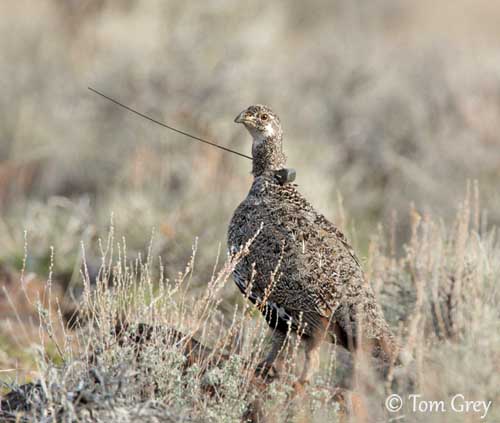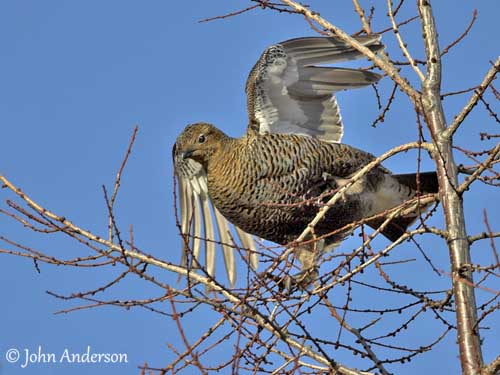
First part: Species's description
Photographers :
John Anderson
John Anderson Photo Galleries
Steve Garvie
RAINBIRDER Photo galleries
Tom Grey
Tom Grey's Bird Pictures
Patrick Ingremeau
TAMANDUA
René Lortie
http://rlortie.ca/
Tom Merigan
Tom Merigan’s Photo Galleries
Text by Nicole Bouglouan
Sources :
HANDBOOK OF THE BIRDS OF THE WORLD Vol 2 by Josep del Hoyo-Andrew Elliot-Jordi Sargatal - Lynx Edicions - ISBN: 8487334156
THE HANDBOOK OF BIRD IDENTIFICATION FOR EUROPE AND THE WESTERN PALEARCTIC by Mark Beaman, Steve Madge - C.Helm - ISBN: 0713639601
FIELD GUIDE TO THE BIRDS OF NORTH AMERICA - National Geographic Society - ISBN: 0792274512
BIRDS OF THE GREAT BASIN – by Fred A. Ryser - Univ of Nevada Pr -ISBN: 0874170796
THE COMPLETE BOOK OF BRITISH BIRDS – Written by “Royal Society for the Protection of Birds” experts - Préface de Magnus Magnusson - Michael Cady- Rob Hume Editors - ISBN: 0749509112
BirdLife International (BirdLife International)
The IUCN Red List of Threatened Species
Wikipedia, the free encyclopaedia
Animal Diversity Web (University of Michigan Museum of Zoology)
XENO-CANTO – Sharing Birds sounds from around the world
FAMILY TETRAONIDAE
Grouses
Second part: Behaviour
Grouses have relatively short, rounded wings, allowing them to reach great speeds very quickly. Their take-off is strong and noisy. Then, the flight is performed with rapid wingbeats interspersed with fast glides on down-curved wings.
Grouses are able to take-off rapidly in order to escape from predators. But unfortunately, such rapid take-off makes them attractive for hunters.

These flights require high energy investment and for this reason they are often short. They usually are reluctant to take flight. If they are disturbed on the ground, they escape by flying only to a nearby tree or vegetal cover.
The two black grouses fly better than their larger relatives, and are able to cover fairly long distances in a single straight flight, only performed with long glides on spread wings.
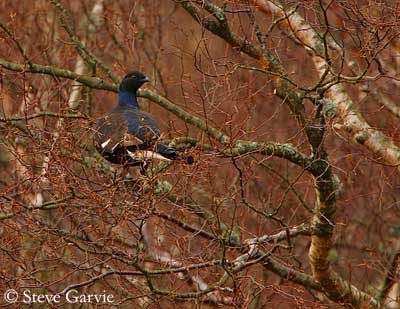
The forest genera such as Falcipennis, Dendragapus, Bonasa and some Tetrao fly only to ascend or descend from trees for feeding, resting or courting.
The Lagopus can be good fliers but they prefer to escape on foot.
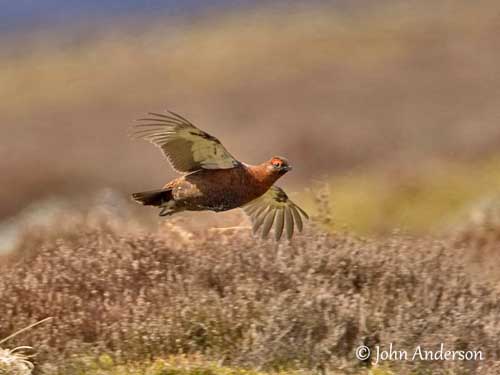
But these terrestrial birds use display flights, as well in territorial activity as in courtship. Even the largest species are able to ascend vertically in a single leap during displays, in the so-called “flutter-flights”.
The mating system of the Tetraonidae includes high frequency of polygyny. Several males compete and display at “leks” or “arenas” which are visited by females.

The birds of genera Centrocercus, Tympanuchus and the two black grouses form typical leks. Males gather together and perform their elaborated displays.
Leks are usually found in clearings in forest species, and on hillocks with short grass and good visibility on the surroundings in grassland species. Each male has only a small territory where it displays.
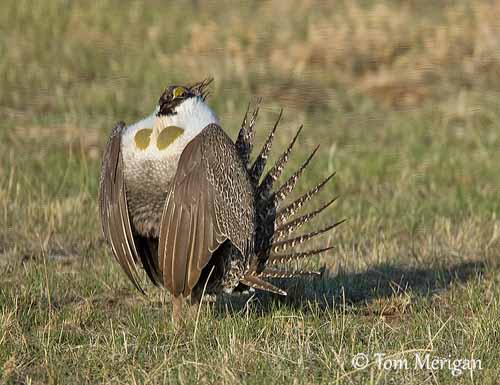
Displays usually take place at dawn and each male defends its small area. The centre of the lek is the more coveted by males, and the first visited by females.
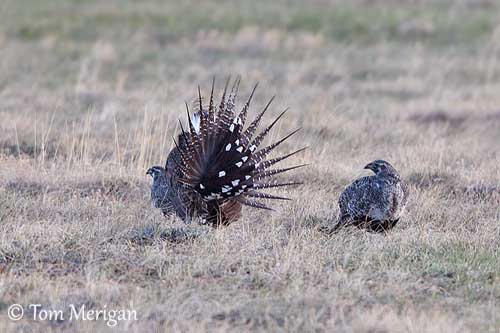
These species have complex and spectacular displays. Males inflate their eye-combs. The prairie-chickens raise their pinnae or elongated neck feathers. The males with cervical sacs puff them out. Ruffs and crest are erect. Wings are dropped until they touch the ground. The tail is cocked to enhance the undertail pattern and the rectrices are shaken while the tail opens and closes abruptly, producing swishing sounds.
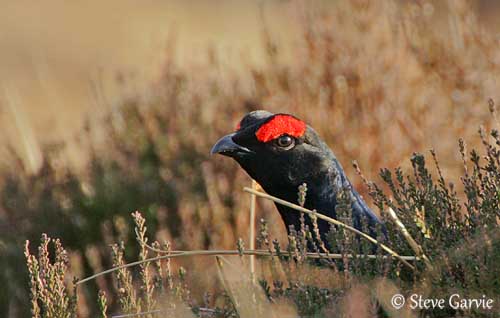

Males drum the ground with their feet in “foot-stamping”, and runs close to each other. By puffing out their air-sacs, they produce far-carrying, low booming sounds.
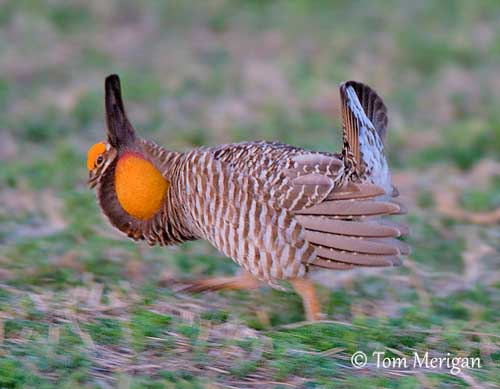
But when females are approaching, the males jump into the air while calling and fluttering rapidly. But jumps, dances, demonstration flights and strutting displays always are amazing to see.
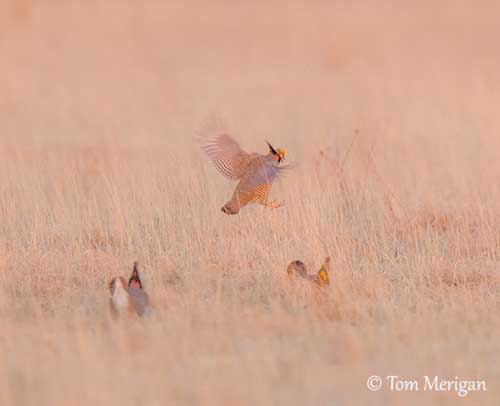
The other genera are usually monogamous or considered intermediate, but their displays are fairly similar.
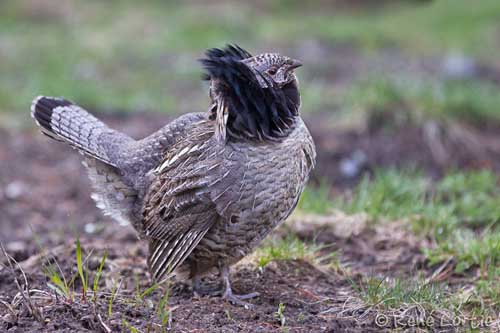
Numerous sounds, noises and calls can be heard while males are displaying.
In addition to be visual signals during courtship, the air-sacs are inflated and produce far-carrying, low booming sounds. Other non-vocal sounds are produced by wings, tail, feet and even bill according to the species. We can hear various hissing, whirring, drumming and swishing sounds.
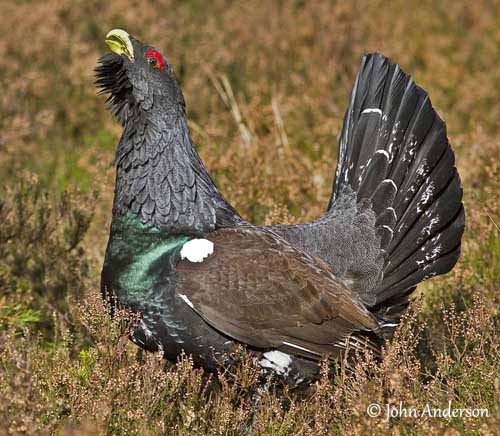
Tetrao urogallus
Calls such as “whoop-calls”, “cackle-calls”, “cork-pop” and hooting are uttered.
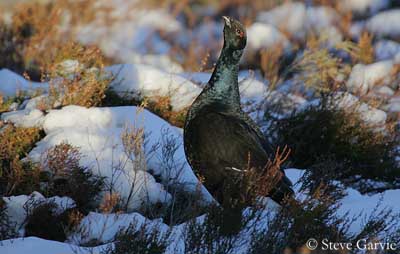
Tetrao tetrix
Females have wider repertoire than males and produce a great variety of calls, usually related to breeding and nesting behaviour. Chicks have very specific calls, a “contact-call” and a “distress-call” and both are immediately answered by their mother.
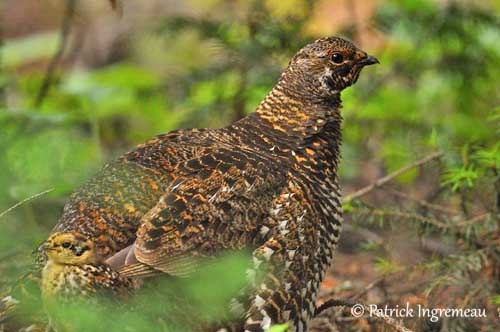
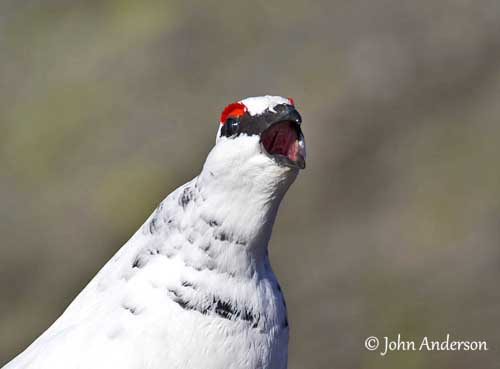
Lagopus mutus
The female chooses the male basing herself on visual and audible factors such as beauty of the plumage, vigour of songs and displays, performance during fights in the lek and hierarchy following these confrontations.
She selects the best male, knowing that all the nesting duties will be assumed by her alone. Copulation takes place at lek or at the edge.
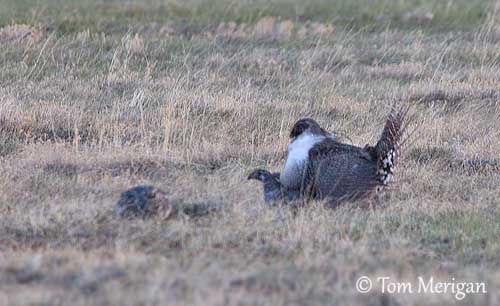
The female selects the nest-site. The nest is usually situated on the ground, but the Western Capercaillie and the Hazel Grouse may occasionally use old abandoned nests some metres above the ground.
The nest is well hidden among the thick vegetation, and even partially covered in species living in open areas. Others are close to tree-trunk or stones in forest species. However, such locations provide some visibility to the incubating female.
The nest is a shallow depression with basic lining such as blades of grass, dry leaves, twigs and sometimes feathers.
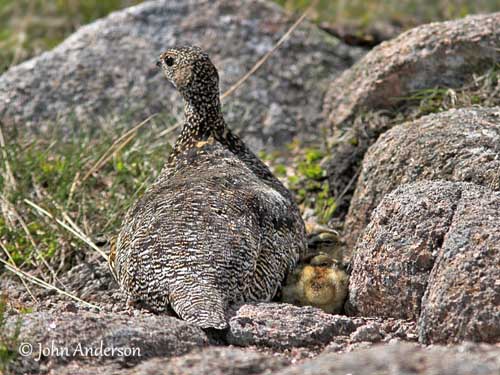
The clutch size ranges from 6-12 eggs depending on the species, but most of them lay 8-10 eggs. Their colour varies but they usually have creamy-buff or yellowish background and dark markings.
The incubation starts once the last egg has been laid. This period lasts from 21 days in Lagopus to 26 days in the Sage Grouse, and is generally longer in the largest species. The incubating female rarely leaves the nest more than 2-3 times a day, often in the early morning and the late evening. Her cryptic plumage provides her an excellent camouflage among the vegetation.
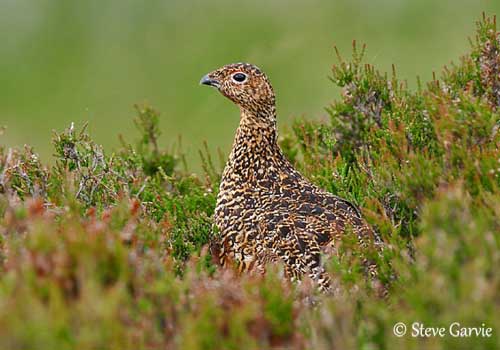
However, predation by mammals and Corvids occurs, involving numerous losses.
If a complete brood is lost, females may lay a replacement clutch after a couple of weeks, but smaller than the first one.
Hatching of all the chicks takes one or two days. As soon as the chicks have dried out, they leave the nest and follow their mother. They are highly precocial. They are able to eat on their own and may travel several hundred metres per day, and they can fly up several metres about ten days after hatching. This is a good way to escape from predators and to spend the night in trees instead on the ground.
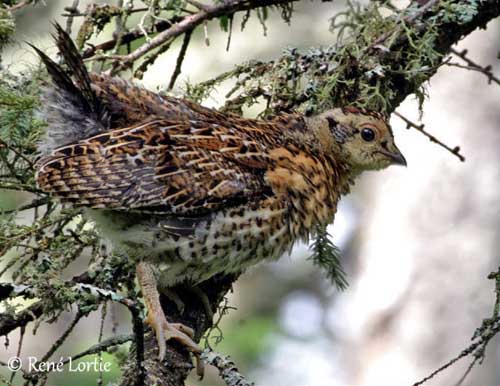
The female leads her brood to areas where the food is abundant. They feed on insects during the first few days. If she gives alarm calls, the brood disperse with chicks running in all directions to hide. She protects them from the climate too, and covers them with her wings to keep them warm.
The chicks grow rapidly and wander farther from their mother while foraging. The family group breaks out when they are three months old.
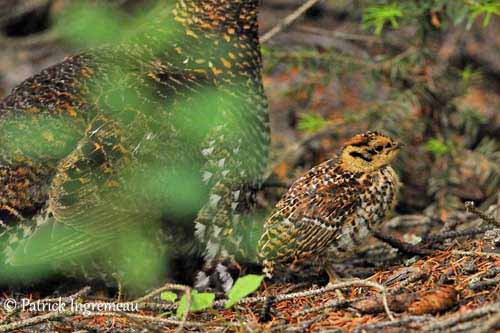
The grouses are vegetarian except for the few days after hatching during which they feed on insects.
During winter, the two Capercaillies, the Blue Grouse and the Spruce Grousefeed on conifer needles, whereas the Ruffed Grouse feeds on aspens, the Willow Grouse on willows, the Black Grouse on birches and the Sage grouse on Sagebrush.
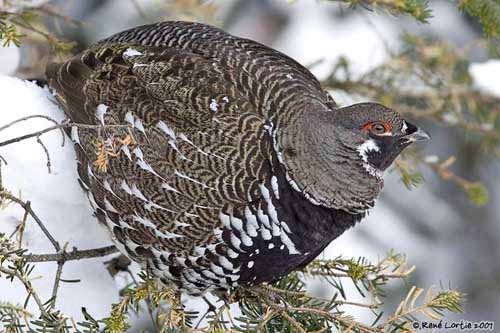
Conifers are the most important plants during winter, but all the plants, trees or bushes, emerging from the snow layer can provide food to the grouses. They consume mainly the buds of the broad-leaved trees and the needles and buds of the conifers.
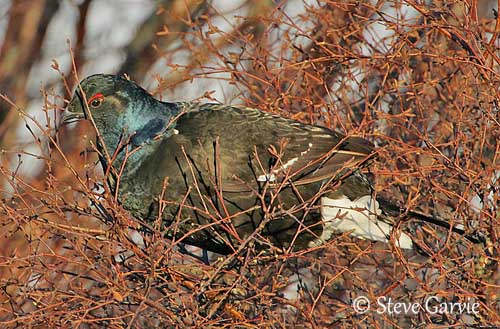
In spring, they can reach the ground vegetation while the snow is melting, and their diet increases in variety with the early flowers of several species. Then, the fruiting plants give them tender leaves and berries during summer. Arthropods are also taken but in low quantities, except the prairie-chickens which eat many insects, and mainly grasshoppers.
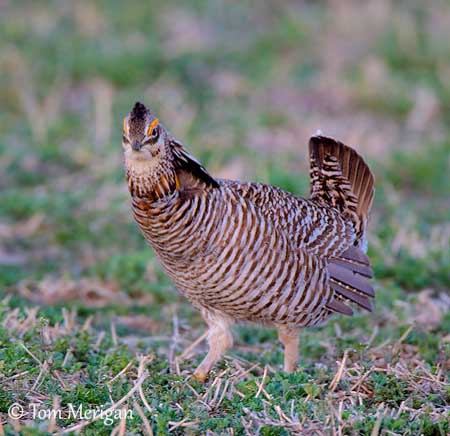
Tympanuchus cupido
Seeds are not eaten, except in prairie-chickens again, especially in winter during which they take sorghum or maize.
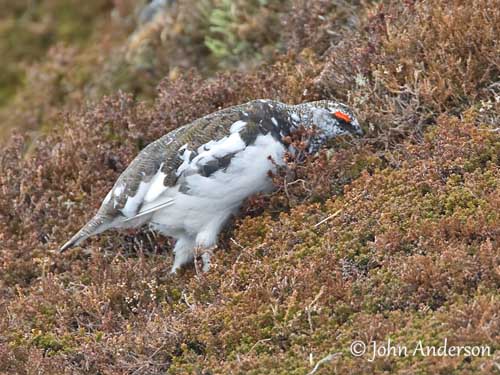
But the grouses have to adapt their diet to the weather conditions and the distribution. There is a food selection in order to consume the more nutritious parts of the plants.
For these birds living sometimes in harsh weather conditions, the food quality is important for breeding success and population health.
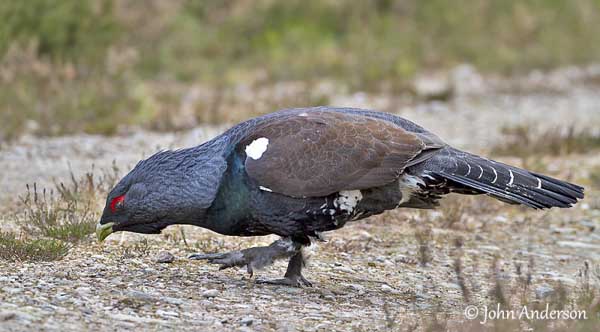
Western Capercaillie - Tetrao urogallus - Male
In spite of several threats such as hunting in the whole range, deforestation, fragmentation and changes in the habitat, disturbances and predation, the Tetraonidae have fairly stable populations.
From BirdLife International and the IUCN Red List of Threatened Species, out of 18 species, five are Near Threatened (Caucasian and Siberian Grouses, Black Grouse, Severtsov’s Grouse and Sage Grouse), and two are evaluated as Vulnerable (Lesser Prairie-chicken and Greater Prairie-chicken).
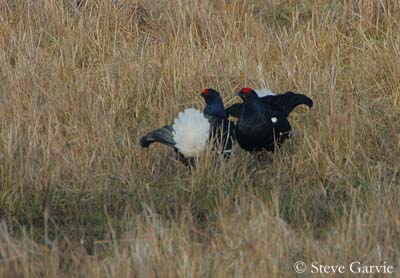
Although these species are exploited as gamebirds, hunting has rarely had an excessively negative impact. These birds are able to survive in harsh weather conditions when food resources are scarce.
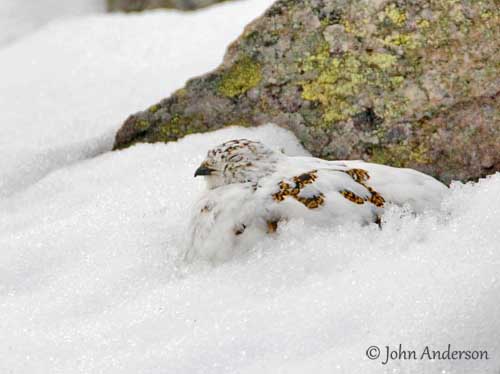
On the other hand, the high birth rates maintain stable numbers in most species and allow rapid recoveries in protected areas or during specially extended close seasons. Hunting appears well managed, as conservation of the habitat.
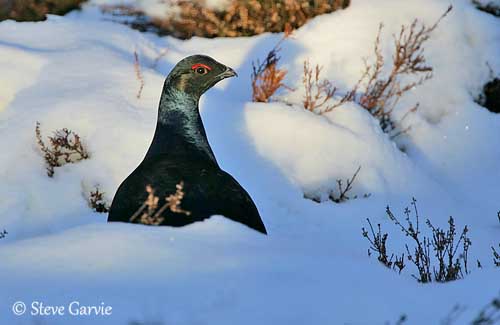
However, populations are everywhere in decline. Currently, conservation measures are under way, allowing hope for better future for these so beautiful birds.
